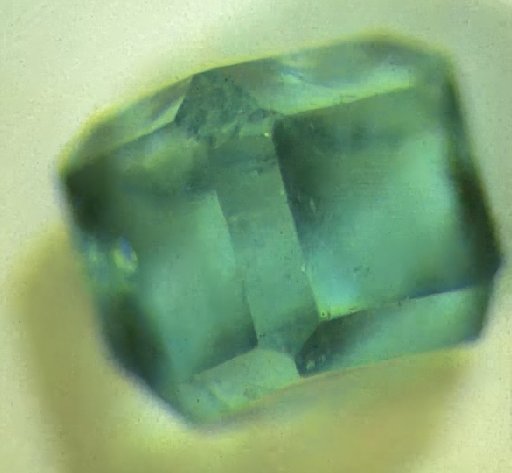Boracite
Boracite ( boracite ), outdated also known as cubical quartz or diamond Lüneburg, is a rarely occurring mineral from the mineral class of " borates " (formerly known as carbonates, nitrates and borates ). It crystallizes in the orthorhombic crystal system with the chemical composition of α - (Mg, Fe) 3 [Cl | B7O13 ] and usually develops isometric crystals, also fibrous or granular to massive aggregates that knows either colorless or by foreign admixtures, gray, yellowish or light - can be colored to dark green.
Special Features
Boracite is polymorphic and switches at a temperature of 268 ° C, its crystal system (see also the crystal structure). The low-temperature form is strongly pyroelectric and forms at ( 111) anti- lied (negative) and at ( 111) analog (positive) pole of.
Furthermore Boracite before the blowtorch only difficult to melt and stain the outer flame green. From hydrochloric acid it dissolves slowly in water, it dissolves easily, however.
Etymology and history
Boracite was first discovered described in Lüneburg limestone mountain in Lower Saxony and in 1787 by G. Lasius as cubic quartz crystals of Lüneburg. Due to its locality and its brilliance, the mineral was also the addition Lüneburg diamond. His final name Boracite got it in 1789 by Abraham Gottlob Werner, who named it after the main ingredient boron.
Other synonyms used by various researchers include calcareous borax, Boraxspath, cube stone ( for Lüneburg), calcareous quartz, Sedativspath ( after H. Westrumb ) and Staßfurtit.
Classification
In the now outdated but still in use 8th edition of the mineral classification by Strunz the Boracite still belonged to the common mineral class of " carbonates, nitrates and borates " and then to the Department of "framework borates ," where he along with Chambersite, Congolith, Ericait and Trembathit an independent group formed.
The 9th edition valid since 2001 and of the International Mineralogical Association (IMA ) used the Strunz'schen Mineral classification assigns the Boracite in the now independent class of " borates " and there in the department of " Heptaborate and other mega borates " one. This division is also further divided by type of crystal structure, so that the mineral according to its design in the sub-division " scaffold Heptaborate ( .05); Layer nano- borates ( .10 to .20 ); Scaffolding Dodekaborate ( .25 ); Mega - framework borates can be found ( .30 to .35 ), " where it forms together with Chambersite and Ericait the unnamed group 6.GA.05.
The mostly commonly used in English-speaking classification of minerals according to Dana assigns the Boracite as the obsolete, the 8th edition Strunz'schen systematics in the common class of " carbonates, nitrates and borates ," there but in the department of " water clear borates with hydroxyl or halogen " one. Here he is as the namesake of the " Boracitgruppe ( Orthorhombic: Rca21 ) " with the system no. Find 25.06.01 and the other members Chambersite and Ericait within the subdivision " Anhydrous borates with hydroxyl or halogen".
Modifications and varieties
The compound α - (Mg, Fe) 3 [Cl | B7O13 ] is dimorphic and is found in nature in addition to the orthorhombic Boracite more than trigonal kristallisierrnder Trembathit ago.
Huyssenit is a ferruginous variety of Boracite. As Eisenboracit however, a Boracite - variety with a mole fraction of up to 36% wustite (FeO ) is called.
A hazy training variant of the Boracite is known as the parasite.
Education and Locations
Boracite formed by sedimentation or metamorphosis in evaporite deposits. Accompanying minerals include anhydrite, carnallite, gypsum, halite, Hildegardit, kainite and sylvite and. Very often it is found in small, one - or grown crystals and geodes. By decomposition, the Boracitkristalle transform without losing their external form in aggregates of fibrous individuals, which contain a few percent of water and a new mineral, Parisit represent.
Overall Boracite has so far (as of 2011) are detected in about 50 localities. Apart from its type locality Lüneburg limestone is the mineral found in Germany nor in several places in Lower Saxony ( Celle, Elze, Göttingen, Hanover, Helmstedt, Hildesheim, Lüneburg), Saxony -Anhalt ( Borde, Staßfurt ) and Thuringia ( Bleicherode, special Hausen, Bad Salzungen ) and at Segeberger Kalkberg in Schleswig -Holstein.
Noteworthy due to exceptional Boracitfunde include the province of Chapare and Cochabamba in Bolivia, where up to 1.5 cm large crystals were found.
Other localities include Tasmania in Australia; Jiangcheng ( Pu'er ) in China; Cleveland and North Yorkshire in England ( United Kingdom ); Lorraine in France; New Brunswick, Canada; Kazakhstan; Muzo in Colombia; Boyacá in Colombia; Inowrocław, Lubin and Kłodawa in Poland; Irkutsk Oblast in Russia; and Clarke County ( Alabama), San Bernardino County and several places in the state of Louisiana in the United States of America (USA).
Crystal structure
Boracite first crystallized in the cubic crystal system in space group F43c with the lattice parameters a = 12.10 Å, and eight formula units per unit cell. At the transition temperature of 268 ° C the crystal lattice folds down into the orthorhombic -pyramidal crystal class, space group Pca21 with the lattice parameters a = 8.55 Å, b = 8.55 Å and c = 12.09 Å and four formula units per unit cell. This particular process of structural change in the same physical state is also called polymorphism.
This property of Boracite is also the reason that often Paramorphosen of Boracite be found by cubic forms.
Use
Boracite has except as a mineral specimen for museums and collectors no meaning. Sometimes, well-educated and clear pieces of hobby grinders are smoothed to faceted gemstones and offered for exchange and / or purchase.










